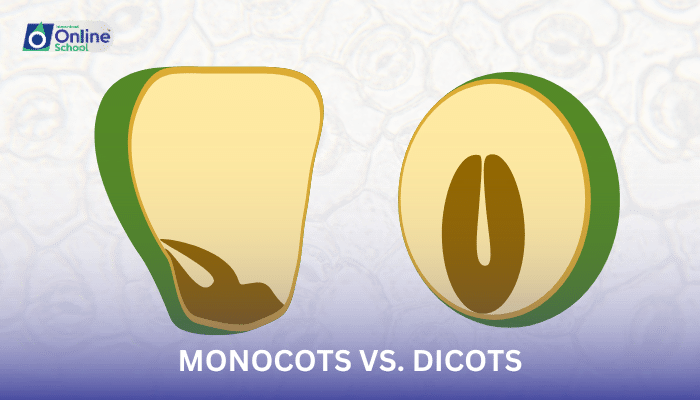
Learning Outcomes:
i. Define angiosperms and their significance in the plant kingdom.
ii. Differentiate between monocotyledons and dicotyledons based on various structural features.
iii. Identify common examples of monocot and dicot plants.
Introduction:
Angiosperms, the most diverse and abundant group of land plants, are characterized by the presence of flowers and the production of seeds enclosed within a fruit. They have successfully colonized a wide range of terrestrial habitats, from deserts and grasslands to forests and wetlands. Angiosperms can be further classified into two major groups: monocotyledons and dicotyledons, based on the number of cotyledons, the first leaves that emerge from the seed.
i. Monocotyledons:
Monocotyledons, also known as monocots, are characterized by a single cotyledon in their seeds. They exhibit various structural features that distinguish them from dicots.
Vascular Bundles: The vascular bundles, responsible for transporting water and nutrients, are scattered throughout the stem of monocots, lacking the distinct arrangement found in dicots.
Leaf Venation: Monocots typically have parallel leaf venation, with veins running parallel to the length of the leaf. This pattern is in contrast to the net-like venation of dicots.
Flower Parts: Monocot flowers typically have floral parts in multiples of three, such as three petals, three sepals, and six stamens.
Root System: Monocots have a fibrous root system, composed of many thin, thread-like roots that spread out near the soil surface.
Examples of Monocots:
- Grasses (rice, wheat, corn)
- Lilies (tulips, lilies of the valley)
- Orchids
- Bananas
- Palm trees
ii. Dicotyledons:
Dicotyledons, also known as dicots, are characterized by two cotyledons in their seeds. They exhibit distinct structural features that differentiate them from monocots.
Vascular Bundles: The vascular bundles in dicots are arranged in a ring pattern around the stem, providing a more efficient transport system.
Leaf Venation: Dicots typically have net-like leaf venation, with veins branching and connecting in a complex pattern.
Flower Parts: Dicot flowers typically have floral parts in multiples of four or five, such as four petals, four sepals, eight stamens, and ten stamens.
Root System: Dicots typically have a taproot system, with a deep, central root that extends into the soil and branches out into smaller roots.
Examples of Dicots:
- Roses
- Beans
- Sunflowers
- Oak trees
- Maples
iii. Significance of Angiosperms:
Angiosperms play a crucial role in maintaining the balance of ecosystems and providing essential resources for human societies.
Ecological Importance: Angiosperms are the primary producers in many ecosystems, forming the base of food webs and providing food and shelter for a wide variety of organisms. They also play a role in nutrient cycling and soil conservation.
Economic Importance: Angiosperms provide numerous resources for human societies, including food (grains, fruits, vegetables), timber (wood for construction), fibers (cotton, linen), and medicines (derived from various plant parts).
Angiosperms, with their diverse adaptations and structural variations, have conquered the land and become the dominant group of plants on Earth. Their ecological and economic significance is undeniable, and they continue to provide essential resources and support the diversity of life on our planet.